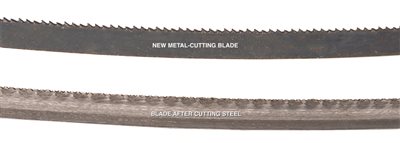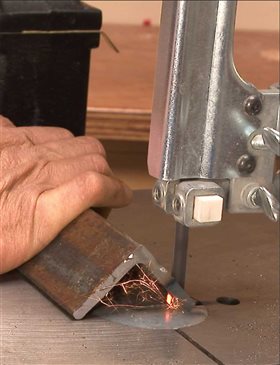Q:
I’ve heard of a technique called
friction-cutting that allows you to cut
steel on a woodworking bandsaw.
What is friction-cutting and does it really
work?
A:
Friction-cutting is used in industry for cutting
iron-base metals, also called ferrous
metals, such as steel. You can adopt the technology
to your woodworking bandsaw to do limited
cutting of ferrous metals in your home shop.
Here’s how it works: Mount a metal-cutting blade
in your bandsaw. The woodcutting bandsaw’s high
speed—3,000 feet per minute (fpm)—will cause
the blade to dull quickly when cutting steel (see
photos, below). However, the friction generated
by the dull teeth will heat the metal to molten red,
allowing the blade to slice through the steel. It’s
amazing when you first try it. You’ll feel some
resistance before the metal reaches the molten
stage, but once it does, you can cut 1/8-in.-thick
steel as though it were 1-in.-thick oak. I tried this
in my own shop and had great results in steel
1/8 in. or thinner. Thicker metal diffuses too
much heat so the metal doesn’t become hot
enough to melt.
Friction-cutting on a woodworking bandsaw
requires a few precautionary measures. Sparks fly
using this method, so be sure to vacuum up all the saw dust in and around your saw beforehand. Also, the blade
can be quite hot after continuous cutting, so keep your saw
running but give the blade a break from cutting from time to
time to let it cool. Otherwise the rubber tire on the wheel
could melt. We recommend using ceramic blocks or the
stock metal-guide blocks that came with the saw.
|
|
Click any image to view a larger version.

Cutting steel at high woodcutting speeds turns a new metalcutting
blade into a dull but effective friction-cutting blade that
can cut up to 1/8-in.-thick steel. CAUTION Be sure to vacuum the dust from your machine
before trying this procedure and disconnect dust-collection
hoses from the saw.
|











